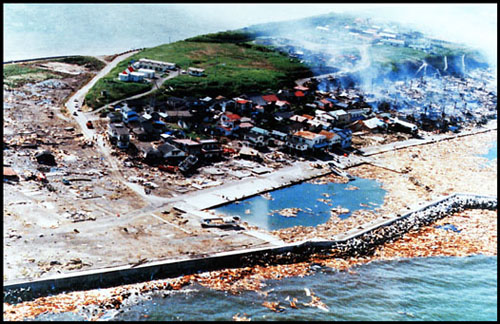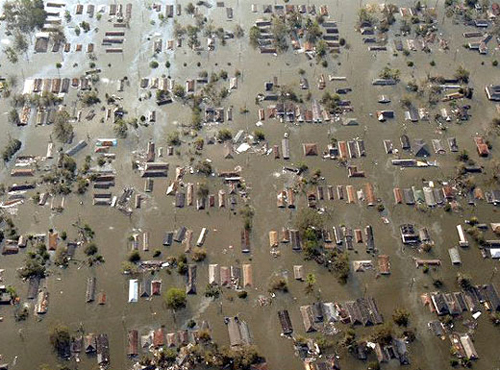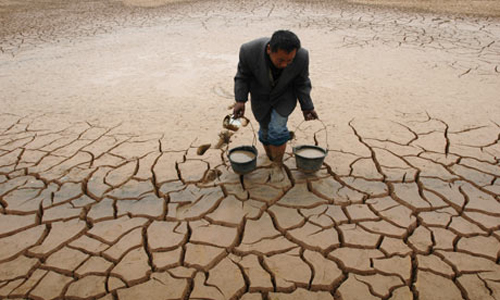
Due to rising population, climate change, and environmental degradation, natural disasters are increasing in frequency. They are also becoming costlier and deadlier, according to Swiss Re, a reinsurance company. In 2009, natural disasters cost insurers about $110 billion. In 2010, the cost was double that, at $218 billion.
According to the World Bank, there are several factors that affect a country’s vulnerability to natural disasters: its geographic size, the type of disaster, the strength and structure of its economy, and prevailing socioeconomic conditions. In a globalized economy, all these factors, as well as others, also play into how the world’s finances will be affected.
With the recent earthquake in Japan, news agencies, economists, and regular people have all been pondering the economics of natural disasters, and what this means for the future.
2011 — Triple Calamity in Japan

It’s still too early to fully comprehend the impact that Japan’s March 11 earthquake and tsunami will have on its national economy, and how that, in turn, will affect the global economy. The area is at risk of seismic activity: a 7.1 magnitude earthquake struck off the coast of Honshu on April 7, rattling residents and relief workers. Also, the world is still waiting to see how the crisis at the Fukushima nuclear power plant will progress. Containing the radioactive material could take months, the plant’s operator’s say. Traces of radiation have been found in a variety of agricultural products, including dairy and spinach, as well as in tap water in Tokyo. With several other nuclear reactors offline as a result of the quake and tsunami, the Tokyo Electric Power Co. has only been able to provide about 75% of their normal kilowatts, resulting in ongoing rolling blackouts in nine of Japan’s prefectures. Japan’s economy is largely export-based, but since the earthquake, manufacturing plants have been forced to shut down. Asian stocks took a dive, with the Nikkei index dropping 6% in a matter of days, though it has climbed steadily in the the three weeks since the quake.
Some economists have been optimistic, pointing at Japan’s quick recovery from the 1995 Kobe earthquake as a model. The earthquake killed over 5,000 people and caused an estimated $100 billion in damages, or roughly 2.5% of Japan’s GDP. Within a year, however, Japan’s economy had more or less recovered, though the Asian stock market took a little longer to rally. Political and financial institutions have taken action to avert a financial meltdown: in the days after the quake, the Bank of Japan announced it would be pumping billions of yen into the economy, as well as giving loans to financial institutions at extremely low interest rates.
Others, like Mohammed A. El-Erian, CEO of the investment company PIMCO, disagree. First, the damage of the March 11 quake and tsunami caused an estimated $200 billion in damage, twice that of the Kobe quake. Japan’s finances are also weaker: despite being the third largest economy in the world, Japan is no longer the economic engine that it once was. Japan’s yearly debt is now twice its GDP, 205%, compared to 85% in 1995. According to El-Erian, “This erodes the flexibility and ultimate effectiveness of fiscal responses.” Also, the ongoing nuclear crisis in Fukushima has rattled confidence in nuclear power, not just in Japan but worldwide as well, driving up prices of renewable energy shares.
It is still too early to see the long-term impact that Japan’s earthquake and nuclear crisis will have. Global commodity prices have been in flux since the disaster: crude oil, of which Japan is a large importer, dropped, while gold and copper prices rose. Agricultural products fell as well, unexpectedly. The crisis has disrupted global supply chains around the world, and Japanese manufacturers still haven’t been able to resume production.
2005 — Hurricane Katrina, and rebuilding New Orleans

Even before Katrina made landfall, New Orleans had many problems. Crime rates were extremely high, nearly eight times than national average. Gang warfare and drug-dealing were endemic to the poor, mostly-black neighborhoods in New Orleans east. Poverty rates in New Orleans were more than twice that of the national average, and even higher in certain areas: the Lower Ninth Ward had a pre-Katrina poverty rate of 36%. The Industrial Revolution had passed by New Orleans like a ship in the night. The economy was mostly based on the service and tourism sectors, which only offered low-paying and transient jobs. Only 7% of people living in the Lower Ninth Ward had a college degree, and 40% had not even graduated from high school.
In the days leading up to Katrina, there was a chain of failures that started among city leaders and went all the way to the White House. Prior to Katrina’s landfall, officials in the city and in the capitol of Baton Rouge were sluggish to act, and dragged their feet in preparing for the storm. On August 27th, a voluntary evacuation was ordered. In the morning of August 28th, it was upgraded to a mandatory evacuation. For the many people in New Orleans without the means or mode of transportation, for the elderly and disabled, the order went unnoticed. Even for those who could leave, the choice to stay and ride out the storm was tempting: thousands of people were still in the city when Katrina hit.
Katrina made landfall on August 29, 2005. Two days later, 80% of New Orleans was flooded, with water breaching the levees in more than 50 places. Parts of the city were under as much as 15 feet of water. Katrina’s estimated death toll was 1,826; about 1,400 of these deaths occurred in New Orleans, where people were stranded by the flooding. The National Hurricane Center estimated that Katrina caused about $81 billion dollars in property damage alone. It was weeks before the city was even inhabitable, and thousands chose not to return to the city. Before the hurricane, the US census estimated there were about 454,000 living in metropolitan New Orleans. Only this year has New Orleans recently surpassed 350,000 citizens. There are still large stretches of abandoned streets, with empty lots and deserted houses. The racial demographics of the city has changed as well; fewer blacks have returned to New Orleans, and fewer young people.
The Journal of Economic Perspectives has estimated that the total financial cost of Hurricane Katrina at about $156 billion dollars. The hurricane, besides devastating people all along the Gulf Coast, disrupted oil production and refinement, destroying several offshore oil platforms and pipelines. Gas prices across the world were temporarily driven up. Its effects on small business owners were also devastating, destroying almost 60% of them. Over 18,000 businesses across Louisiana permanently closed their doors after the 2005 hurricane season. Long before the recession, New Orleans lost an estimated 70,000 jobs. The tourist industry took an understandable hit: the number of visitors to the city has still not reached pre-Katrina numbers. For a long time, the only business sector that saw any growth was the construction industry, which was kept busy with the city’s hurry-up-and-wait reconstruction. Efforts to rebuild were also hampered by the Deepwater Horizon oil spill last spring, and the global recession.
In New Orleans, where rents were historically cheap, housing costs have skyrocketed. Low-income housing areas took the worst damage from Katrina, and little has been done to alleviate rising rents. The issue is a hot topic in the city and the surrounding parishes, bound up in class and racial tensions. Homelessness is a persistent problem. Crime rates have remained higher than the national average, and the city’s infrastructure has still not completely recovered. Food security remains an issue for poor residents, with many having to choose between paying their bills and buying the month’s groceries.
Still, despite the ongoing discouragement, some in New Orleans are optimistic. The Brookings Institute, an independent research organization, put together a report called “The New Orleans Index At Five”. The report finds that, despite numerous setbacks, New Orleans could be on its way to building a city that is “a healthier, more resilient region.” There are currently efforts in place to overhaul the city’s justice, health care, and education systems. There is also a movement to restore areas of the city to natural coastal wetlands, which could act as a buffer to future storms. With continued effort, particularly in the areas of poverty and housing relief, New Orleans could be a success story.
2004 — Lessons from the Indian Ocean Tsunami

The 2004 Indian Ocean Tsunami is one of the deadliest disasters in recorded history. Deathtoll estimates have ranged from 230,000 to 300,000. Entire communities were wiped out, whole families washed away. In some ways, it was also the first global disaster. Fourteen different countries were affected, in Asia and Africa; victims came from all over the globe, as popular tourist destinations were among those devastated by the waves.
The financial impact of the tsunami varied by country. Fishing and tourist industries were the hardest hit. Smaller countries like the Maldives and Sri Lanka, in particular, were dependent on tourist revenues. The tsunami destroyed many resorts, as well as infrastructure like roads and railways. Overall, however, the macroeconomic effect of the tsunami was minimal. Tourism has rebounded in many of the affected areas, with well-intentioned foreigners eager to support affected countries.
The most interesting economic lessons from the tsunami are actually about foreign aid. Governments, corporations, NGOs, and private individuals worldwide pledged donations to help relief efforts. Initial estimates of aid pledges totaled close to $10 billion. Unfortunately, the number of donors, in some ways, worked against the victims of the tsunami. Coordinating relief efforts was a logistical nightmare. Smaller countries such as Sri Lanka and Indonesia, which were the worst hit by the tsunami, were ill-prepared to deal with receiving and distributing aid, and international organizations were often at odds. Some of the “lateral aid” that came in, such as foodstuffs and clothing, was quite useless to survivors in some countries, despite being given in good will. The Foreign Minister in Sri Lanka even reported receiving a container full of teddy bears.
Two years on, it was apparent that relief had still not reached some of those who needed it most. Much of the money that was pledged for reconstruction efforts had not been spent: less than 50% of some government’s donations, in fact. The majority of those who had been rendered homeless in the four worst-off countries — Sri Lanka, Indonesia, the Maldives, and Thailand — had still not been moved into permanent housing.
There has also been misuse of relief and reconstruction funds, as corruption and internal conflict took its toll. In Sri Lanka, donations were diverted into funding the conflict between the government and the Tamil Tigers, a violent separatist group, which was only resolved in May of 2009. There have also been accusations of country’s tourist boards misusing aid in Tamil Nadu and Kerala, trying to court tourists instead of helping coastal communities rebuild.
2010 — Repeating mistakes in Haiti

Haiti is the poorest country in the Western Hemisphere, ranking 145th out 169 countries on the Human Development Index. It has a violent history. For much of the twentieth century, Haiti was ruled by the father and son dictators, “Papa Doc” and “Baby Doc” Duvalier, who created the death squads that were responsible for the deaths of thousands of Haitians. Baby Doc’s ouster in 1986 led to a period of upheaval that lasted until the mid-90’s, when the UN intervened to restore a fragile peace. In the years since, Haiti has still been characterized by human rights abuses, fraudulent elections, and overwhelming poverty.
As a small, densely-populated, and economically fragile country, Haiti is extremely vulnerable to natural disasters. When a 7.1 magnitude struck 16 miles from the capitol of Port-Au-Prince, the effects were devastating. The estimated death toll was 300,000, with over a million homeless, and hundreds of thousands of buildings destroyed. Like in the 2004 tsunami, the global financial impact of this disaster was negligible, though it devastated local Haitian economies. Also like the 2004 tsunami, the lessons it offers from its deadlocked relief efforts are of more interesting to this post.
Rather than learning from the mistakes and missteps of the 2004 Asian tsunami, the international community seems bent on repeating them in Haiti. Immediately following the earthquake, donations and aid pledges poured in: individual, corporate, and governmental aid totaled close to 3.5 billion. Yet Haiti has made little progress in its recovery, beset by setbacks at almost turn. Power struggles and rivalry prompted criticism as the international media covered stories on squabbling agencies. When the US took over the Port-Au-Prince airport, for instance, it created a bottleneck that made it harder for other countries’ donations and relief workers to get through. A group of missionaries was arrested for child trafficking, after illegally trying to take a group of “orphans” across the Dominican border. In October, foreign aid workers caused a cholera outbreak, resulting in over 3,000 deaths, and prompting anti-UN riots.
One year later, little of the promised aid has been delivered, less than 10% according to the U.N. In addition, there are funding gaps in necessary areas like debris removal and school building. Very little of the rubble has been cleared, and most of Haiti’s homeless are still living in camps, where violent incidents and sexual assaults are increasing. No reconstruction has actually begun. “Haitians want to get back to work and provide for their families,” said <Roland Van Hauwermeiren, country director of international aid organization Oxfam. “They aren’t asking for charity, but for a chance to be part of the process to rebuild their own country. After going through so much last year, Haitians deserve that chance.”
2010/2011 — Droughts, floods, and drought in China

2010 set records was the hottest year in one of the hottest decades in history. Climate change, exacerbated by the effects of El Niño, sparked off a series of global heat waves. In Pakistan, temperatures rose to 128.3 Fahrenheit on May 26, the highest temperature seen in Asia. Russia was beset by a series of wildfires, wiping out crops and forests, and blanketing cities in smog. People across Europe had to be hospitalized for heat stroke and dehydration as air-conditioning failed to bring relief.
In China, several southwestern provinces began to see a major drought in the spring, the worst in close to a century. Tens of millions of people faced water shortages, wild fires, and crop failures. Many people living in rural villages had no choice but to leave their homes, as wells and reservoirs ran dry. The government even resorted to cloud-seeding in an effort to relieve the parched provinces. Dust storms choked the northern provinces, causing hazardous conditions in cities across the Asian continent.
The drought caused an estimated $3.5 million dollars in immediate damage, both to agriculture and to the country’s hydroelectric sector. There are also other uncounted, but still very real costs from the drought: drought can lower the overall productivity of land due to erosion and topsoil loss. It can reduce livestock herds and yields. According to some flooding and landslides, with almost 200 more missing. Before the end of the summer, the death toll would rise into the thousands. 15 million people were evacuated, and over a million homes destroyed. 13.5 million hectares of crops were affected by floodwaters, with at least 2 million completely destroyed. By August, direct damage from the floods was estimated at $41 billion.
Altogether, 2010’s drought and flooding has cost China about $75 billion. In 2011, fears of another drought, this time affecting the northern wheat-producing regions, fanned fears of a worldwide food crisis, and drove global grain prices up. The Chinese government spent nearly $15 billion in direct relief and subsidies to farmers, trying to keep the region from buckling under pressure. So far, China has spent an average of $35 billion a year since 2004 counteracting the effects of extreme weather, and the numbers are increasing each year. As climate change increases the likelihood of natural disasters, will China’s drought-flood-drought become a pattern, and will it slow the economic powerhouse’s growth? Time will tell.